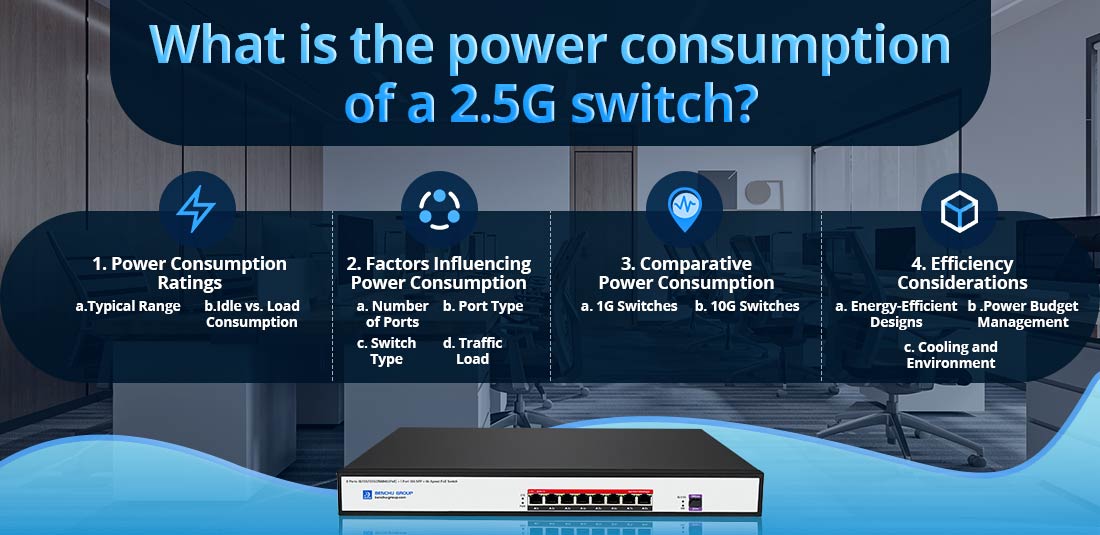
La consommation électrique d'un commutateur 2,5G peut varier en fonction de plusieurs facteurs, notamment la conception du commutateur, le nombre de ports, les types de ports (par exemple, Ethernet standard ou Power over Ethernet (PoE)) et la charge de travail globale sur le changer. Voici une description détaillée des considérations en matière de consommation d’énergie pour un commutateur 2,5G :
1. Cotes de consommation d'énergie
Gamme typique : La consommation électrique d'un commutateur 2,5G standard varie généralement de 10 watts (W) à 50 W. Les commutateurs plus petits et non gérés avec moins de ports ont tendance à consommer moins d'énergie, tandis que les commutateurs gérés plus grands avec de nombreuses fonctionnalités et ports peuvent en consommer davantage.
Consommation en veille ou en charge : Comme la plupart des périphériques réseau, un commutateur 2,5G consomme moins d'énergie lorsqu'il est inactif (ne transmet pas activement de données) que lorsqu'il est en charge (transmet activement des données). Par exemple, un commutateur peut consommer 10 W lorsqu'il est inactif et augmenter jusqu'à 30 W ou plus lorsqu'il est à pleine charge, en fonction du trafic et du nombre de connexions actives.
2. Facteurs influençant la consommation d'énergie
Plusieurs facteurs peuvent influencer la consommation électrique d’un switch 2,5G :
Nombre de ports : Plus un commutateur possède de ports, plus il consomme généralement d’énergie. Par exemple, un commutateur 2,5G à 8 ports peut consommer moins d'énergie qu'un commutateur à 24 ports. Chaque port actif peut ajouter une petite quantité de consommation d'énergie, surtout si les appareils sont connectés et transmettent activement des données.
Type de ports : Si le commutateur inclut des fonctionnalités Power over Ethernet (PoE), sa consommation électrique sera plus élevée car il doit alimenter les appareils connectés (tels que les caméras IP, les téléphones VoIP ou les points d'accès sans fil) en plus de la connectivité réseau. Un commutateur PoE peut nécessiter une consommation électrique de 15,4 W à 30 W par port PoE, selon la norme PoE (par exemple, PoE, PoE+ ou PoE++).
Type de commutateur : Les commutateurs gérés consomment généralement plus d'énergie que les commutateurs non gérés en raison de leurs fonctionnalités supplémentaires, telles que la gestion du trafic, la prise en charge des VLAN et les capacités de surveillance avancées. Toutefois, la puissance supplémentaire peut être justifiée par une efficacité et une gestion améliorées du réseau.
Charge de trafic : La quantité de données transmises affecte également la consommation d'énergie. Un commutateur qui gère un volume de trafic élevé consommera plus d’énergie qu’un commutateur qui est principalement inactif. Pendant les heures de pointe d’utilisation, vous constaterez peut-être une consommation d’énergie plus élevée en raison de l’augmentation de la transmission de données.
3. Consommation électrique comparative
Pour comprendre la consommation électrique des commutateurs 2,5G dans leur contexte, il peut être utile de les comparer avec les commutateurs 1G et les commutateurs à vitesse plus élevée :
Commutateurs 1G : Généralement, la consommation électrique des commutateurs 1G varie de 5 W à 30 W, selon la taille et les fonctionnalités. Dans de nombreux cas, les commutateurs 2,5G sont légèrement plus gourmands en énergie en raison de leurs capacités de débit plus élevées et des fonctionnalités supplémentaires qu'ils peuvent offrir.
Commutateurs 10G : Ces commutateurs ont tendance à avoir une consommation d'énergie nettement plus élevée, allant souvent de 40 W à 200 W, selon leur conception et leurs caractéristiques. Cela signifie que si les besoins de votre réseau dépassent les capacités d'un commutateur 2,5G, le passage à un commutateur 10G nécessitera beaucoup plus de puissance, ce qui peut avoir un impact sur vos coûts énergétiques et vos besoins de refroidissement.
4. Considérations d'efficacité
Pour gérer efficacement la consommation d’énergie, tenez compte des éléments suivants :
Conceptions économes en énergie : Recherchez des interrupteurs conçus dans un souci d’efficacité énergétique. Certains fabricants proposent des modèles dotés de modes basse consommation, de fonctionnalités d'économie d'énergie ou des normes IEEE 802.3az (Energy Efficient Ethernet), qui réduisent la consommation d'énergie pendant les périodes d'inactivité.
Gestion du budget d'alimentation : Pour les commutateurs PoE, il est crucial de comprendre votre budget énergétique. Assurez-vous que la puissance totale requise pour tous les appareils PoE connectés ne dépasse pas la capacité du commutateur. De nombreux commutateurs PoE permettent de gérer l'allocation de puissance pour éviter les surcharges.
Refroidissement et environnement : Une ventilation et un refroidissement adéquats dans la zone où le commutateur est installé peuvent également avoir un impact sur l'efficacité énergétique. La surchauffe peut entraîner une augmentation de la consommation d'énergie, car les commutateurs peuvent limiter leurs performances pour maintenir un fonctionnement stable.
5. Estimation des coûts totaux de l'électricité
Pour estimer le coût total de l’énergie nécessaire au fonctionnement d’un commutateur 2,5G sur une année, vous pouvez utiliser la formule suivante :

Par exemple, si un commutateur 2,5G consomme 30 W, fonctionne 24 heures sur 24 et que l'électricité coûte 0,12 $ par kWh :

Conclusion
En résumé, la consommation électrique d'un commutateur 2,5G varie généralement de 10 W à 50 W, influencée par le nombre de ports, la présence de capacités PoE, le type de commutateur (géré ou non géré) et la charge de trafic. Même si les commutateurs 2,5G consomment légèrement plus d'énergie que leurs homologues 1G, leurs avantages en matière d'efficacité et de performances justifient souvent les coûts énergétiques, en particulier dans les environnements nécessitant une bande passante plus élevée et des capacités de transmission de données plus rapides.
En sélectionnant des modèles économes en énergie et en gérant efficacement les budgets d'alimentation, les utilisateurs peuvent minimiser leurs coûts opérationnels tout en profitant des performances améliorées offertes par les commutateurs 2,5G.